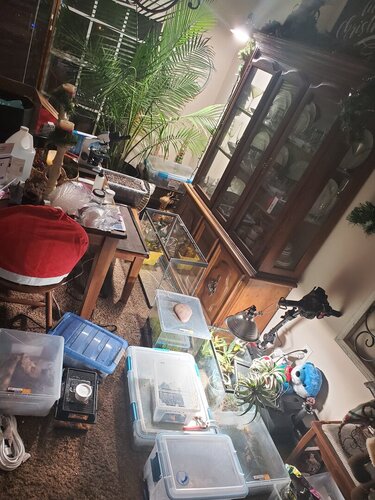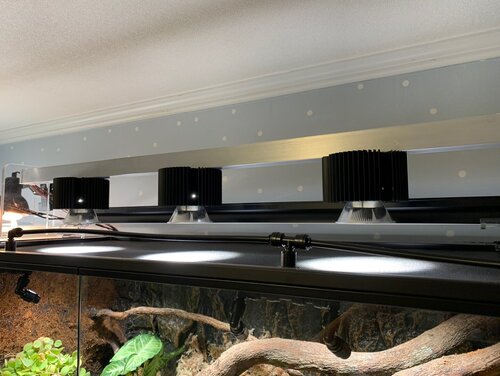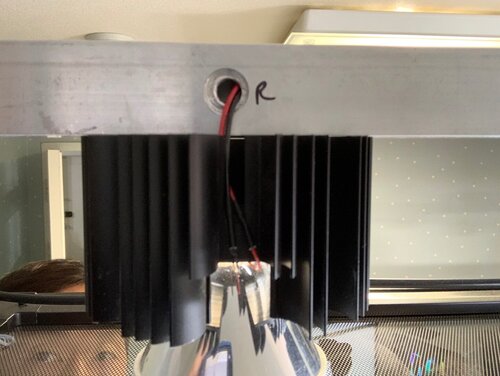The Wild One
Chameleon Enthusiast
What are some plant/grow lights that y'all use for bioactive vivs? I know that @GoodKarma19 @jamest0o0 and @Brodybreaux25 have done some, have y'all used any? If so what kind and wattage?
Follow along with the video below to see how to install our site as a web app on your home screen.
Note: This feature may not be available in some browsers.
Um it looks good, maybe something a little lower priced?Currently running two HLG 65 quantum boards on my 36x18x36, and 2 SunBlaster 6500k linear plant lights on my screen cage. The quantum boards are fabulous, but the drivers are running hot on mine which led me to suspend them 8" above the cage. They're also extremely bright, to the point that I've rigged up "blinders" out of black foam board.
Um it looks good, maybe something a little lower priced?
These are where it’s at! I get enough light at the bottom of a 5ft enclosure to keep bromeliads happy. It also doubles as the basking light. Not cheap but also not crazy expensive. The perfect choice in my humble opinion.YU MEIL LED Pool Light Bulb 120V 45W 6500K White Light
I have recently replaced my incandescent basking bulbs with the YU MEIL 45W LED.Ill do 2 of each there will be 11 different species of plants, do you think that will be enough? The enclosure did indoors by the way.
Well... this is 1 of each [24W and 36W]. Don't mind the mess, it's an experiment as we're moving. As you can see I have everything from bromeliads to literal grass.Ill do 2 of each there will be 11 different species of plants, do you think that will be enough? The enclosure did indoors by the way.

Oh sorry I meant 1 of each lolWell... this is 1 of each [24W and 36W]. Don't mind the mess, it's an experiment as we're moving. As you can see I have everything from bromeliads to literal grass.
View attachment 253583
It's a mess as I'm always adding/removing plants and starting new projects. My wife isn't happy that I stole the dinning room, but as stated, we're moving next month anyway.


In the back right, by the window, is my palm (rather large). In that clear box with blue handles is my sheet moss. It gets ample light being so far from the light source and under the palm.Oh sorry I meant 1 of each lol
^^^^If you have the time and patience, DIY LED is a great way to go. I use Bridgelux Vero COB LED arrays connected to a Coralux StormX Arduino-based controller. DIY allows you the freedom to control every aspect of your lighting and you can typically go much stronger than anything you would find in a retail bulb or fixture. A single Vero 29 COB LED can use up to 80 watts. I use mostly the Vero 18s which can take up to 31 watts each and are *incredibly* bright at max intensity. I can't even comprehend what 80 watts on a Vero 29 would be like. Arduino-based PWM controllers like the StormX allow me to slowly ramp up the intensity in the morning and dim at night, along with other neat effects like cloud cover simulation.
View attachment 253584View attachment 253585
If you have the time and patience, DIY LED is a great way to go. I use Bridgelux Vero COB LED arrays connected to a Coralux StormX Arduino-based controller. DIY allows you the freedom to control every aspect of your lighting and you can typically go much stronger than anything you would find in a retail bulb or fixture. A single Vero 29 COB LED can use up to 80 watts. I use mostly the Vero 18s which can take up to 31 watts each and are *incredibly* bright at max intensity. I can't even comprehend what 80 watts on a Vero 29 would be like. Arduino-based PWM controllers like the StormX allow me to slowly ramp up the intensity in the morning and dim at night, along with other neat effects like cloud cover simulation.
View attachment 253584View attachment 253585